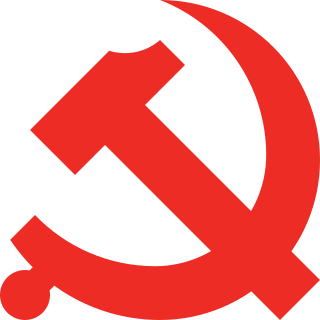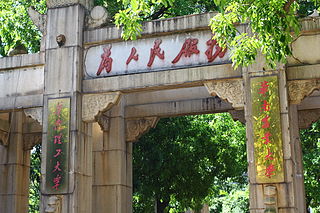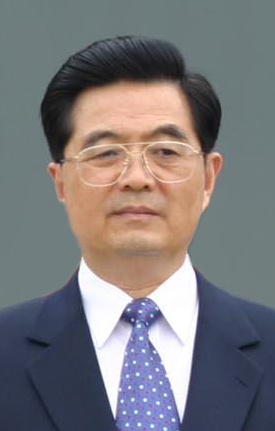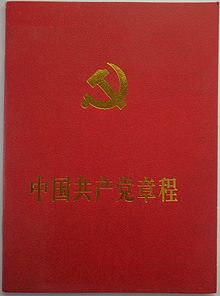
The Chinese Communist Party (CCP), officially the Communist Party of China (CPC), is the founding and sole ruling party of the People's Republic of China (PRC). Under the leadership of Mao Zedong, the CCP emerged victorious in the Chinese Civil War against the Kuomintang. In 1949, Mao proclaimed the establishment of the People's Republic of China. Since then, the CCP has governed China and has had sole control over the People's Liberation Army (PLA). Successive leaders of the CCP have added their own theories to the party's constitution, which outlines the party's ideology, collectively referred to as socialism with Chinese characteristics. As of 2023, the CCP has more than 98 million members, making it the second largest political party by membership in the world after India's Bharatiya Janata Party.

The Three Represents or the important thought of Three Represents is a guiding socio-political theory within China credited to then-general secretary of the Chinese Communist Party (CCP), Jiang Zemin, which was ratified at the 16th Party Congress in 2002. The Three Represents defines the role of the CCP. Jiang Zemin first introduced his theory on 25 February 2000 while on an inspection tour in Maoming, Guangdong province.
The debate over democracy in China has been a major ideological battleground in Chinese politics since the 19th century. China is not a liberal or representative democracy. The Chinese Communist Party (CCP) and the Chinese government state that China is a "socialist democracy" and a "people's democratic dictatorship" and a dictatorship of the proletariat. Under Xi Jinping, China is also termed a "whole-process people's democracy". Many foreign and some domestic observers categorize China as an authoritarian one-party state, with some saying it has shifted to neoauthoritarianism. Some characterize it as a dictatorship. In contrast Taiwan is one of the most democratic in the world.

The Yan'an Rectification Movement was a political mass movement led by the Chinese Communist Party (CCP) from 1942 to 1945. The movement took place in the Yan'an Soviet, a revolutionary base area centered on the remote city of Yan'an. Although it was during the Second Sino-Japanese War, the CCP was experiencing a time of relative peace when they could focus on internal affairs.

"Serve the People" is a political slogan and the motto of the Chinese Communist Party (CCP). It originates from the title of a speech by Mao Zedong, delivered in September 1944.
New Democracy, or the New Democratic Revolution, is a concept based on Mao Zedong's Bloc of Four Social Classes theory in post-revolutionary China which argued originally that democracy in China would take a path that was decisively distinct from that in any other country. He also said every colonial or semi-colonial country would have its own unique path to democracy, given that particular country's own social and material conditions. Mao labeled representative democracy in the Western nations as Old Democracy, characterizing parliamentarianism as just an instrument to promote the dictatorship of the bourgeoisie/land-owning class through manufacturing consent. He also found his concept of New Democracy not in contrast with the Soviet-style dictatorship of the proletariat which he assumed would be the dominant political structure of a post-capitalist world. Mao spoke about how he wanted to create a New China, a country freed from the feudal and semi-feudal aspects of its old culture as well as Japanese imperialism.

Deng Xiaoping Theory, also known as Dengism, is the series of political and economic ideologies first developed by Chinese leader Deng Xiaoping. The theory does not reject Marxism–Leninism or Maoism, but instead claims to be an adaptation of them to the existing socioeconomic conditions of China.
The mass line is the political, organizational and leadership method developed by Mao Zedong and the Chinese Communist Party (CCP) during the Chinese Communist Revolution. It refers to formulating policy based on theory, implementing it based on people's real world conditions, revising theory and policy based on actual practice, and using that revised theory as the guide to future practice. In Maoist terms, it is summarized by the phrase, "To the masses - from the masses - to the masses".

The Scientific Outlook on Development, sometimes translated to either the scientific development concept, or as the scientific development perspective, is one of the guiding socio-economic principles of the Chinese Communist Party (CCP), credited to former Chinese leader Hu Jintao and his administration, who was in power from 2002 to 2012.
The history of the Chinese Communist Party began with its establishment in July 1921. A study group led by Peking University professors Chen Duxiu and Li Dazhao to discuss Marxism, led to intellectuals officially founding the Chinese Communist Party (CCP) in July 1921. In 1923, Sun Yat-sen invited the CCP to form a United Front, and to join his Nationalist Party (GMD) in Canton for training under representatives of the Communist International, the Soviet Union's international organization. The Soviet representatives reorganized both parties into Leninist parties. Rather than the loose organization that characterized the two parties until then, the Leninist party operated on the principle of democratic centralism, in which the collective leadership set standards for membership and an all powerful Central Committee determined the party line, which all members must follow.
The Constitutional history of the People's Republic of China describes the evolution of its Constitutional system. The first Constitution of the People's Republic of China was promulgated in 1954. After two intervening versions enacted in 1975 and 1978, the current Constitution was promulgated in 1982. There were significant differences between each of these versions, and the 1982 Constitution has subsequently been amended several times. In addition, changing Constitutional conventions have led to significant changes in the structure of the Chinese government in the absence of changes in the text of the Constitution.

Red tourism is tourism at locations significant to communism. It is a subset of domestic and international tourism in current or former communist countries such as China and Russia, in which people visit locations with historical significance to their "red" (communist) past.
Chinese scholars, thinkers, and policy-makers have debated about democracy, an idea which was first imported by Western colonial powers but which some argue also has connections to classic Chinese thinking.
People's democratic dictatorship is a phrase incorporated into the Constitution of the People's Republic of China and the Constitution of the Chinese Communist Party. The premise of the "People's democratic dictatorship" is that the Chinese Communist Party (CCP) and state represent and act on behalf of the people, but in the preservation of the dictatorship of the proletariat, possess and may use powers against reactionary forces. The term forms one of the CCP's Four Cardinal Principles. Implicit in the concept of the people's democratic dictatorship is the notion that dictatorial control by the party is necessary to prevent the government from collapsing into a "dictatorship of the bourgeoisie", a liberal democracy, which, it is feared, would mean politicians acting in the interest of the bourgeoisie. This would be in opposition to the socialist charter of the CCP.
The Chinese Communist Party (CCP) frames its ideology as Marxism adapted to the historical context of China, often expressing it as socialism with Chinese characteristics. Major ideological contributions of the CCP's leadership are viewed as "Thought" or "Theory," with "Thought" carrying greater weight. Influential concepts include Mao Zedong Thought, Deng Xiaoping Theory, and Xi Jinping Thought. Other important concepts include the socialist market economy, Jiang Zemin's idea of the Three Represents, and Hu Jintao's Scientific Outlook on Development.
The organization of the Chinese Communist Party (CCP) is based upon the Leninist concept of democratic centralism.

Democratic centralism is the organisational principle of communist states and of most communist parties to reach dictatorship of the proletariat. In practice, democratic centralism means that political decisions reached by voting processes are binding upon all members of the political party. It is mainly associated with Leninism, wherein the party's political vanguard of revolutionaries practice democratic centralism to select leaders and officers, determine policy, and execute it.

Xi Jinping Thought on Socialism with Chinese Characteristics for a New Era, commonly abbreviated outside China as Xi Jinping Thought or Xi'ism, is an ideological doctrine created during General Secretary Xi Jinping's leadership of the Chinese Communist Party (CCP) that combines Chinese Marxism and national rejuvenation. According to the CCP, Xi Jinping Thought "builds on and further enriches" previous party ideologies and has also been called as the "Marxism of contemporary China and of the 21st century". The theory's main elements are summarized in the ten affirmations, the fourteen commitments, and the thirteen areas of achievements.
Wu Guixian is a Chinese politician who served as China's first female vice premier from January 1975 to September 1977. Originally a worker at a state-owned cotton factory in Xianyang, she was appointed by party leader Mao Zedong after becoming the factory's deputy director and a member of the Central Committee of the Chinese Communist Party.
Historical nihilism is a term used by the Chinese Communist Party (CCP) and some scholars in China to describe research, discussions, or viewpoints deemed to contradict an official state version of history in a manner perceived to question or challenge the legitimacy of the CCP. The CCP opposes historical interpretations that are critical of it, the People's Liberation Army, socialism, and related topics. Viewpoints that the state judges to be historical nihilism are subject to censorship and legal prosecution.










